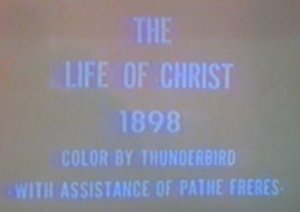Jone o Gli ultimi giorni di Pompei (Ione or The Last Days of Pompeii, 1913)
So the recent showing of one of the two 1913 Italian versions of the film at Kenington Bioscope's Seventh Silent Film weekend proved irresistible: It ticks all my boxes, as a love of Italian cinema, silent movies and the potential for a biblical character as well.That potential is only slight. In the novel – itself inspired by Karl Briullov's painting "The Last Day of Pompeii" – four characters end up being Christians (after Olinthus converts Apaecides and Glaucus and Ione convert later), but there are no biblical characters from what I recall.
As it turned out, I was to be disappointed on the biblical characters front: The film sticks in its lane and doesn't even really explore the Christianity angle. Nevertheless I thought I may as well record a few thoughts here while I was at it.
As I mentioned above 1913 witnessed two Italian versions of the story being made. The more famous one, directed by Eleuterio Rodolfi and possibly Mario Caserini (who was one of the earliest Italian cinema pioneers, directing a stack of Shakespearean and historical films) is simply called Gli ultimi giorni di Pompei (a literal translation) and had been produced by Ambrosio – one of the major film production companies in pre-WWI Italy, based in Turin. You can view it on Wikipedia. The handouts/notes for the day, written by the Italian silent historical film expert Ivo Blom identified this as the original film. Apart from anything, it was Ambrosio who had had success with the 1908 version. Blom explains that
"when Ambrosio heard that the rival company Pasquali, their city rival, was going to release an equally ambitious, impressive film on the same subject and launched at the same time, they were seething. Yet not even appeals to the court could stop the release of Pasquali's version which had its premiere in Rome four days after the Ambrosio version".
Yet aside from local rivalry, there were other reasons why both companies may have set their hearts on adapting Bulwer-Lytton's novel. Firstly, earlier in the year another adaptation of a 19th century novel based on the mid-first century Roman Empire had enjoyed huge success. To say the 1913 Quo Vadis? was a groundbreaking movie is something of an understatement: it redefined the possibilities of what historical cinema could be, set the bar to a new height in terms of spectacle and grandeur and was celebrated across the globe. So film producers did what film producers tend to do and looked for the nearest bandwagon they could jump on. Ben-Hur was tied up in a legal case, but Last Days was evidently very much available.
The other key motivation was that Vesuvius (very much the villain of the piece) had erupted again in 1906, killing 100 people and activity began stirring again in 1913 (though not as dramatic) so despite the story being set 1850 years in the past, it had particular modern relevance.
I've yet to see the Ambrosio version, but, sadly the Pasquali version (directed by Giovanni Enrico
Vidali and Ubaldo Maria del Colle) was kind of dull. Not knowing the story, it was hard to get much sense of the plot, particularly as the available intertitles were displayed too briefly to be able to read them. I'm not sure if any other prints of the film still exist, but were it to ever get a DVD/ digital release I hope they extend the duration of the title that remain.
From what I could work out, though, Nydia, a slave/servant with a visual impairment, essentially helps Glaucus and Jone escape the evil (pagan) priest Arbaces (played by Vidali, one of the directors). The individual scenes feel very much like they could have been shot in a early 20th century country house and are fairly pedestrian, but for the fact that Suzanne De Labroy who plays Nydia overacts quite badly.
There were a couple of shots of the crowd, big shots designed to impress and to showcase the 300 people who purportedly starred in the film, but the camera angles were very unconventional, betraying a sense that they didn't have have enough extras to fill a normal shot and so had to cram the ones they did have into a narrow frame. The production also advertised “100 lions and tigers” and they, along with the wider amphitheatre shots are the highlight, ably abetted by the horses.
What I did find interesting, however, is the way the film adopts Maggi’s innovative stumble-past-the-camera shot as seen in both Ambrosio's earlier Last Days (1908) and his later Giuda (1911). It’s not an exact reproduction, but it certainly seems like a nod. Or was it just a rip-off? Perhaps it was a way to leave audiences thinking they had seen the Ambrosio remake – that seems a little far fetched though.
Sadly. in contrast with the 1908 film, the climax of the Pasquali film was a little disappointing. Things descended into chaos, but the moment the volcano erupts felt a little sedate. But perhaps that's on me. Perhaps, with a serious volcanic eruption lodged in the collective memory, too great a proportion of the film's potential viewers might object to over-the-top, Hollywood-style, pyrotechnics.
===========
For a different (and, lets face it, better) take on the film have a look at the review of my blog-twin Paul Joyce over at his IThankYouArthur blog who reviewed the whole day.
Labels: Peplum films, Silent Bible Film Mysteries



























